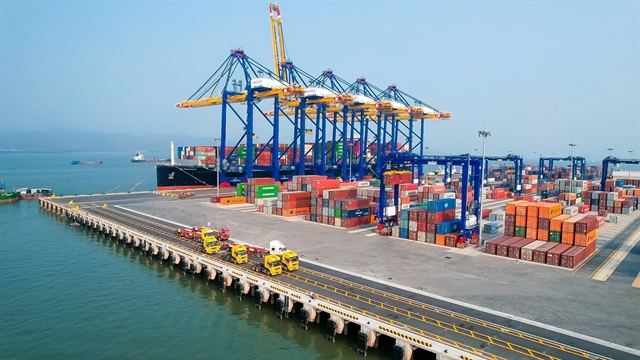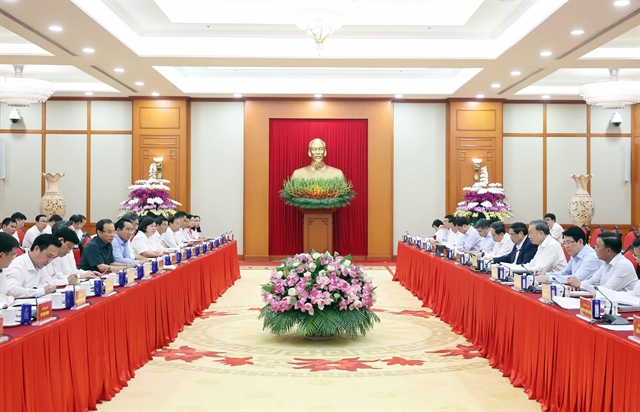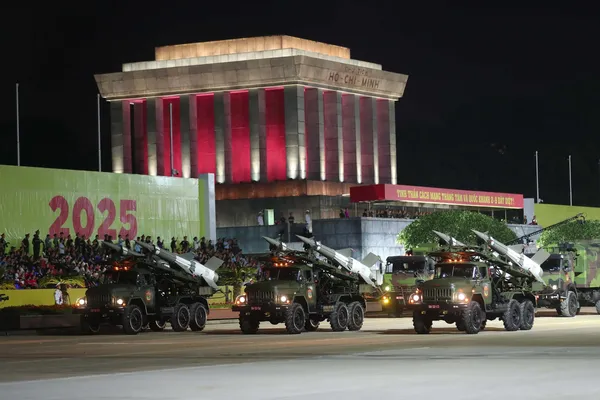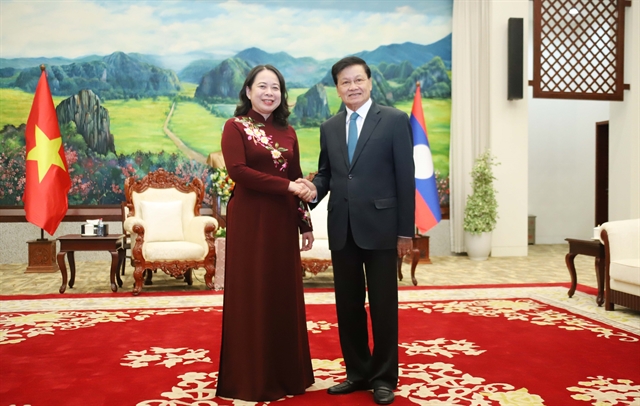 Economy
Economy


|
| Siemens ASEAN and Việt Nam CEO Dr Phạm Thái Lai. — Photo courtesy of the company |
Siemens ASEAN and Việt Nam CEO Dr Phạm Thái Lai spoke to Việt Nam News on how digitalisation can help alleviate the energy crisis and accelerate the energy transition.
In your opinion what are some most critical impacts caused by the energy crisis?
Energy is one of the biggest cost drivers for industrial plants as well as for buildings, community facilities, campuses, and countless similar entities. In the light of rising energy costs and increasingly strict environmental regulations, this challenge is becoming even greater.
We are experiencing an energy crisis that is fueling inflation with a severe impact on households and businesses all over the world and is forcing factories to curtail their production or even shut down, citizens are asked to reduce their energy consumption while governments scramble to secure alternative fuel sources.
The energy crisis has genuinely doubled down on the urgency to follow a stringent decarbonisation pathway in all areas of human activity. This affects the industry, building, transportation, and energy sectors – the way we produce goods, the way we construct and use buildings, the way we move and all manner of goods, and the way we produce, transport, and use electricity.
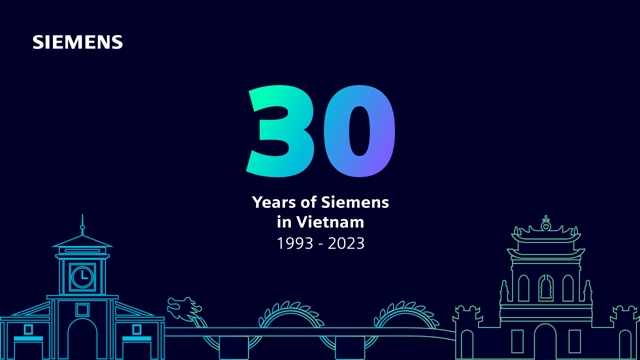
|
| Siemens has marked its 30th anniversary of official establishment in Việt Nam. — Photo courtesy of the company |
And what are the critical levers for a sustainable energy transition?
Efforts to combat climate change are gaining momentum worldwide, and the use of technology plays a crucial role in this endeavor. Across various countries, there are ambitious projects focusing on large-scale decarbonisation to transform economies and energy systems.
In my view, there are four main levers that can drive these efforts. The first lever centers around fuel switching, which entails decarbonising our power supply by significantly increasing the adoption of solar and wind energy.
Projections suggest that globally, renewable energy sources must expand by a factor of 30 by 2050 to achieve the desired impact. The second lever is electrification, where we need to prioritise the conversion of energy consumption across different sectors to electricity-based alternatives.
Presently, the global electrification rate stands at approximately 22 per cent, but to make a substantial impact, it must surpass 50 per cent by 2050. Energy efficiency forms the third lever.
To make significant strides in mitigating climate change, we must focus on reducing energy consumption by addressing demand and adopting more efficient energy usage practices. This approach has the potential to lead to nearly a 50 per cent reduction in energy consumption.
Lastly, the fourth lever is speed, which is a crucial aspect of digital transformation. In today's rapidly evolving business landscape, organisations need to adapt quickly to remain competitive and relevant.
Digital transformation entails leveraging technology to fundamentally alter how businesses operate, deliver customer value, and innovate products and services. Customers often inquire about achieving digital transformation more easily, rapidly, and at scale.
The answer lies in open, digital platforms like Siemens Xcelerator. Siemens Xcelerator is a robust digital business platform designed to accelerate digital transformation. It comprises a curated portfolio, a partner ecosystem, and a marketplace to expedite value creation across the industry, buildings, grids, and mobility sectors. By leveraging Siemens Xcelerator, organisations can streamline their digital transformation journey and achieve impactful results in the fight against climate change.
In the context of the energy crisis, which sectors should we focus on and how?
There are two sectors that stand out for their impact on keeping us sheltered and safe and for their readily available solutions. They are the building sector, which accounts for 40 per cent of the global energy usage, and the energy grid, which has to simultaneously cope with a huge surge in demand – energy consumption is set to double in the next 20 years, and peak demand will triple – as well as increasing volatility due to stochastic renewable energy generation.
The answer is digitalisation. It is impossible to manage the complexity of buildings, grids, and cities reliably and efficiently without smart, automated solutions. As a welcome side effect, putting digital solutions at the core of the energy transition will also reduce the need for costly hardware investment.
How can digitalisation support the evolution of the energy grid in particular?
Digitalisation will assist grid operators in their quest for stability in the absence of centralised generation assets. Storage solutions are key for grid stability and digitalisation is required to manage such solutions.
Faced with volatility and uncertainty at the edge of the grid, operators are currently struggling to cope. Substantial conventional investments in power lines and transformers are of course still necessary, but will by themselves not solve the challenge we are facing. Grid software solutions will help to substantially diminish those costs by making the grid smart without massive investment.
In addition, grid software cuts technical and non-technical losses, reduces the time for troubleshooting, decreases OPEX, and increases flexibility and thus even the capacity of a grid.
The flows in the network can be managed much more efficiently, and there is a strong indication that digitised grids could even transport twice as much energy.
Dealing with volatility becomes more feasible if there is real-time, actionable data, for example from Meter Data Management Systems, to inform contingency planning.
AI will also be able to improve situational awareness by estimating future scenarios, such as the effect of the rapid growth of electric vehicles and renewable energy on a certain grid area.
Grid management with digital twin technology not only enables the sustainable integration of decentralised renewable energy resources to the grid but also accelerates the energy transition.
Approaches for the central management of corresponding data not only benefit the optimisation of processes in the classic functions of grid operation and grid planning, but also support analyses in connection with renewable grid infeed, enabling the efficient synchronisation and thus qualitative improvement of data from different sources across all operational phases and operational units, and generally improve the transparency and controllability of the grid.
So how has Siemens been helping to digitalise Vietnamese grids?
Siemens has been actively supporting Việt Nam’s digital transformation journey, including the digitalisation of the national network distribution grids.
Back in 2014, Siemens supplied and installed SCADA/DMS system for Việt Nam's FIRST unmanned 110kV substation which created a totally new concept of operation. We also supplied the SCADA/DMS control centres for 26 provinces in the northern region of Việt Nam.
These projects have significantly improved the availability and efficiency of the distribution grids in this region and reduced power outages, thus contributing to economic development.
Siemens is a leading supplier of efficient power transmission solutions. We have delivered equipment protection and automation solutions for hundreds of 110kV-220kV substations as well as dozens of 550kV substations.
Among them, the Thủy Nguyên 220kV substation can be considered a lighthouse project of the sector. It’s the first 220kV digital substation of Việt Nam’s transmission grid which was equipped with Siemens Process Bus technology thus supporting customers to provide a more secure, efficient, flexible, and intelligent electric system.
As a part of Siemens Xcelerator portfolio, Siemens Grid Software Suite enables our customers to accelerate and secure the energy transition in a sustainable and profitable way.
For example, Siemens DEOP (Distributed Energy Optimisation Programme), a cloud-based SaaS has enabled Trung Nam Group to optimise the operation of distributed energy resources at Trung Nam-Thuận Nam solar farm. Siemens software has enabled them to monitor its energy production, the energy emission into the grid, and the performance and economic revenues generated.
Furthermore, we provide Utility and Industry solutions for simulating and calculating software thus helping our customers to centralise network data as well as digitalise network models for simulation, analysis, and planning purposes.
To sum up, we strongly believe that digitalisation can help alleviate the energy crisis and accelerate the energy transition in the world and in Việt Nam. And Siemens is well positioned to support its customers to unlock their full potential of digitalisation. — VNS

